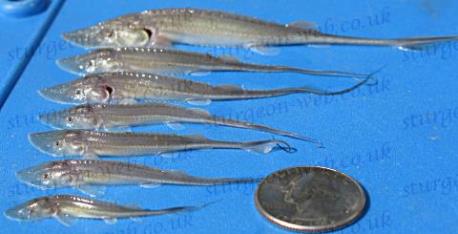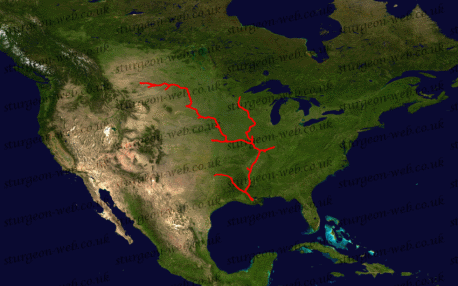Shovelnose sturgeon (Scaphirhnchus platorynchus)
U.S. Fish and Wildlife Service biologist Andy Plauck talks about efforts to save the Pallid and Shovelnose Sturgeons
The Shovelnose Sturgeon (Scaphirhynchus platorynchus) is the smallest growing native American sturgeon species. The maximum recorded size is 1m in length and 4.8kg in weight but 50 - 85cm and up to 2.5kg is more usual.![]()
The Shovelnose Sturgeon is not as commonly available for sale in the U.S. as the White Sturgeon (Acipenser transmontanus), which grows far to large for most garden ponds but is nevertheless often seen for sale as an aquarium fish! The Shovelnose Sturgeon's adult size makes it a much more suitable choice for pond keepers and a good alternative to the Sterlet (Acipenser ruthenus), especially for would be sturgeon keepers in the U.S where true Sterlets are hard to find for sale.![]()
Natural hybrids occur in the wild between the larger Pallid Sturgeon (Scaphirhynchus albus) and the Shovelnose Sturgeon which both spawn in the Mississippi and Missouri Rivers.![]()
Description
Scaphirhynchus platorynchus has 13-19 dorsal scutes, 38-50 lateral scutes, 9-14 ventral scutes, 29-36 dorsal fin rays and 18-24 anal fin rays. The skin colour is a light brown to olive on the back to white on the belly. The common name comes from the shape of the snout which is flat and shovel-like. The Shovelnose Sturgeon can reach 1 meter in length and weigh up to 4.8kg.![]()
Recommended Pond Size

Shovelnose Sturgeon (Scaphirhynchus platorynchus) Ohio Department of Natural Resources photo
If you are lucky enough to find one for sale, a Shovelnose Sturgeon will need a pond of at least 4,500 litres (1,000 gallons) but bigger is better, more than 9,000 litres (2,000 gallons) is recommended if you want to keep the fish into adulthood.
Food & Feeding
Sturgeons DO NOT, as some people would have you believe, eat banket weed or 'clean the bottom of the pond'. Sturgeons need to be fed all year round, they need 2-3% of their body weight of good quality food per day in the summer, less in the winter.![]()
A healthy sturgeon diet must contain a high level of animal protein, sturgeons need a minimum protein content of 40% and an oil level of 15% or more. A a small percentage of the protein can be obtained from soya but the majority needs to be from fishmeal or other animal sources.![]()
Pellet to Sturgeon size:
- 2mm pellet Starter Diet Sturgeon 10-20cm (4-8in)
- 3mm pellet Sturgeon 20-36cm (8-14in)
- 4.5mm pellet - sturgeon size 30-50cm (12-20in)
- 6mm pellet Sturgeon 36-61cm (14-24in)
- 8mm pellet Sturgeon over 61cm (24in)
Stellatus (Acipenser stellatus) and Sterlets (Acipenser ruthenus) have smaller throats; use a size smaller for them.
Buy sturgeon food pellets from Orchard Fisheries »
For more information feeding your sturgeon see our Sturgeon Food and Feeding page.![]()
Health Issues

Juvenile Shovelnose Sturgeons (Scaphirhynchus platorynchus) from the Missouri River - USFWS Midwest Region photo
The most common sturgeon health problems are food and/or oxygen related, get these two vital things right and your sturgeons should remain fit and healthy.![]()
Use an oxygen test kit to make sure there is enough oxygen in the water. Follow the instructions that come with the kit to ensure correct results. Do not assume that there is plenty of air just because you have an air pump running. Many things can affect the amount of dissolved oxygen in the water so testing is the only way to be certain. Warm water holds less oxygen than cold water so be vigilant during hot weather, especially stormy nights when the oxygen may drop to dangerously low levels suddenly.![]()
Feed your sturgeon plenty of the correct food all year round. For more information about feeding your sturgeon see our Sturgeon Food and Feeding page.![]()
Avoid strong chemical treatments such as formalin/formaldehyde, Potassium permanganate, Copper sulphate or any treatment that states not to be used with Golden Orfe (Leciscus sp.) or Rudd (Scardinius reythrophathalmus), these will probably kill your sturgeon. Salt is the safest treatment to use with sturgeons. For more information about treating your sturgeon see our Medications and Treating Sturgeons page.![]()
Provide the best possible water quaility for you fish. Run the pump and filtration all year round and keep a spare back up pump in case of main pump failure. For more information about water quality see our Water Quality page.![]()
Wild distrubution

Shovelnose Sturgeon (Scaphirhynchus platorynchus wild distrubution map
The Shovelnose Sturgeon is a potamodromous (freshwater only) North American species occupying the Mississippi and Missouri river basins, including the lower Ohio River. Athough once occuring as far upstream as Pennsylvania, the Shovelnose sturgeon is now rarely found above Newburg, Indiana. The species is still relatively abundant below Smithland Locks and Dam.![]()
The Shovelnose Sturgeon is one of the most abundant species in the wild but is still listed as 'Vulnerable' on the IUCN Red List of Threatened Species. The construction of dams and other alterations to the rivers has reduced the Shovelnose Sturgeon's range by about 30% and blocked access to ancestral spawning grounds. The species is being reproduced in captivity to restock the rivers![]()
Taxonomy
Kingdom: Animalia
Phylum: Chordata
Subphylum: Vertebrata
Superclass: Osteichthyes
Class: Actinopterygii
Subclass: Chondrostei
Order: Acipenseriformes
Suborder: Acipenseroidei
Family: Acipenseridae
Subamily: Scaphirhynchinae
Genus: Scaphirhynchus
Common names
Sand Sturgeon, Shovelnose Sturgeon
Links
Encyclopedia of Life | FAO Species Fact Sheet | Fishbase | ITIS | Pond Life
Written by Terry White
Contents
Home
Sturgeon Species
Sturgeon Care
Sturgeon Health
Water Quality
Our Other Sites

Copyright © 2000-2024
www.sturgeon-web.co.uk
All Rights Reserved.
Protected by UK Copyright Service Registration No:311386
